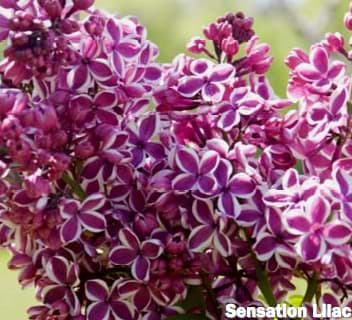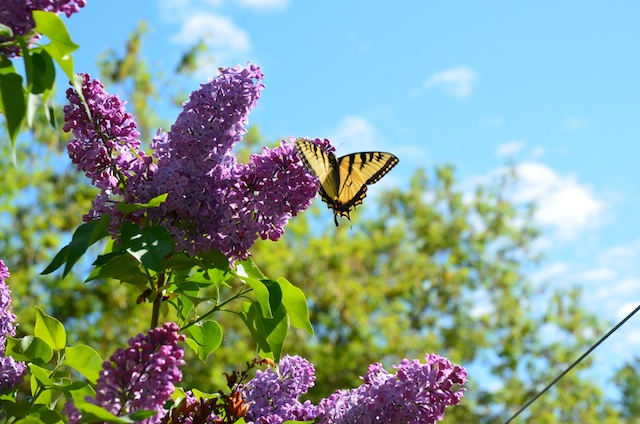
This is Sensation Lilac. Only one I know that has multi-colour petals. I think it's my favorite.
Lilacs
A Rural Tradition

One reason to plant lilacs.
Lilacs are one of those shrubs that people either love
or hate. Some love the scent of the blossoms in spring.
Others find it cloying. My wife loves both the fragrance, and the
masses of tiny blooms in the spring. I love the butterflies and industrious hum of both bumble and honey bees.
A few miles away from here there is an abandoned homestead surrounded by lilacs. I imagine that at one point they were on either side of a door or window. The farmer could only plough so close to the old house, so the lilacs spread all the way around.
When I was not much bigger than a garden gnome my father planted a ring of lilacs about 8 feet across on one edge of our property. When I was twelve, and wanting a place to hide from parents who had unreasonable expectations about weeding and mowing, I would take my book and burrow into the lilac room. It was green shade everywhere, and soundless but for the summer noise of bugs and birds. And perhaps a distand lawnmower run by one of my friends that day.
Lilacs tend to get open and ratty looking with time, but maintaining them is easy: Each year take out 2-3 of the biggest, most disreputable stems in each plant. Do this right after they bloom, for maximum flowers the next year.
Each year let the suckers grow until they are about 3-4 feet tall. Select 3-4 of the strongest ones that are in the right place to maintain a nice looking shrub. Remove the others.
With the badly suckering ones, you make have to make a second round of sucker harvesting in late summer. All three activities take only a few minutes per shrub per year.
The lilac forms next year's flower buds a month after finishing this year's. If you postpone pruning, you are likely to take off a lot of next year's buds, which will make it look very odd when it blooms.
Some species sucker with a certain enthusiasm. Suckers mow easily when small. Plant in the lawn, rather than as a backing to to a flower bed.
If they get ahead of you for a few years, give them a chainsaw haircut. They will come back from the roots. You won't have any flowers the first year after this treatment.
If you have time, prune the blossoms off once they finish. The shrub will pour energy into growth rather than seed.
On the other hand, the seed heads are interesting for dried displays for autumn.
Seeds are appreciated by birds and rodents.
As a group the lilacs are shrubs ranging from a few feet to just over gutter height. They are noted for their huge clumps of tiny flowers in spring.
Common Lilacs These are the two easily available lilacs grown from seed. They are genetically different -- not clones. I bring in a thousand or so 2 year old seedlings for people doing a hedge on a budget.
Fancy Lilacs These are ones that come in other colours. Most of these are special order, although I often get a few each year. They come in a much wider selection of colours, and will be more consitent in size as they grow.
Tree Lilacs One main trunk with a cloud of flowers in early summer. These are all special order. Ask by September.
Inventory tables are double rows to make them usable on small screens.
Common name and container in column 1.
Count is how many we think we have left. Price is per tree.
Height will be there next year, we hope.
Leaf -- Lilac
| Common Name Container |
Count Price |
Height (feet) |
|
| Lilac, Charisma #5 Std pot (15 qt) |
5 $60.00 |
||
| Lilac, Common #1 Std pot (3 qt) |
225 $7.00 |
||
| Lilac, Common #1 Std pot (3 qt) |
6 $12.50 |
||
| Lilac, Common #2 Std pot (6 qt) |
-5 $25.00 |
||
| Lilac, Common #5 Std pot (15 qt) |
3 $42.50 |
||
| Lilac, Common 1-2 yr Bare Root Seedling 25/bundle |
225 $3.50 |
||
| Lilac, Japanese Tree 'Ivory Silk' #15 Std pot (45 qt) |
4 $160.00 |
||
| Lilac, Japanese Tree 'Ivory Silk' #7 Std pot (21 qt) |
7 $140.00 |
||
| Lilac, Late #1 Std pot (3 qt) |
16 $9.00 |
||
| Lilac, Late #2 Std pot (6 qt) |
225 $30.00 |
||
| Lilac, Late #5 Std pot (15 qt) |
21 $47.50 |
||
| Lilac, Late 1-2 yr Bare Root Seedling 25/bundle |
100 $3.50 |
||
| Lilac, Little Boy Blue #5 Std pot (15 qt) |
4 $70.00 |
||
| Lilac, Little Lady #1 Std pot (3 qt) |
200 $25.00 |
||
| Lilac, Little Lady #2 Std pot (6 qt) |
-20 $25.00 |
||
| Lilac, Little Lady #5 Std pot (15 qt) |
67 $60.00 |
||
| Lilac, Madame Lemoine #5 Std pot (15 qt) |
3 $60.00 |
||
| Lilac, Miss Kim #5 Std pot (15 qt) |
9 $70.00 |
||
| Lilac, Pinktini #2 Std pot (6 qt) |
5 $45.00 |
||
| Lilac, Pinktini #2 Std pot (6 qt) |
-1 $60.00 |
||
| Lilac, Pinktini #4 Std pot (12 qt) |
-4 $60.00 |
||
| Lilac, Pinktini #5 Std pot (15 qt) |
8 $60.00 |
||
| Lilac, Sensation #2 Std pot (6 qt) |
1 $35.00 |
||
| Lilac, Sensation #5 Std pot (15 qt) |
1 $60.00 |
||
| Lilac, Sensation #5 Std pot (15 qt) |
2 $70.00 |
||
| Last Update: 2024-Jan-21 | |||
Got something to say? Email me: sfinfo@sherwoods-forests.com
Interesting? Share this page.
Want to talk right now? Call me: (8 am to 8 pm only, please) 1-780-848-2548
Do not arrive unannounced. Phone for an appointment. Why? See Contact & Hours That same page gives our hours of operation.
Back to Top
Copyright © 2008 - 2021 S. G. Botsford
Sherwood's Forests is located about 75 km southwest of Edmonton, Alberta. Please refer to the map on our Contact page for directions.
